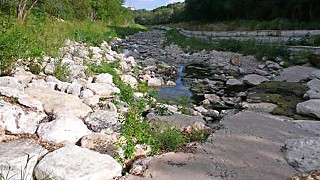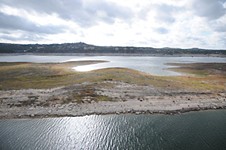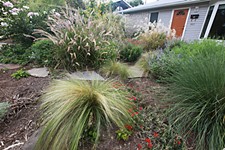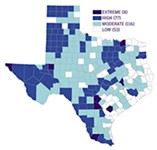Ending the Water War
What if enviros and the city partnered on conservation?
By Katherine Gregor, Fri., Sept. 11, 2009

Stacked neatly at the Austin Water Utility are boxes and boxes of brochures about water conservation. I'm thumbing through a selection now, provided by AWU staff: coloring and activity books for kids, Water IQ campaign materials, brochures on fixing leaky faucets, toilets, pools. The stack includes pretty leaflets about native-plant landscaping, irrigation systems, lawn maintenance, and Austin's outdoor watering ordinance. (The latter are now out-of-date, as tougher drought-induced restrictions took effect Aug. 24.) The utility also has stacks of applications for its free toilet program, rebates on toilets and washing machines and rain barrels, free irrigation-system audits, and more. Of course, neither these voluntary programs nor the informative brochures will actually reduce the city's water consumption – until and unless they motivate Austinites to change their behavior. On the scale necessary to help refill Lake Travis – or forestall the construction of Water Treatment Plant No. 4 – such voluntary conservation programs require massive, effective outreach and public education to make a real dent in water usage. AWU has done some of that work, but not with first-rate sophistication, strategies, or results.
Meanwhile, Austin has three environmental groups with canvassing teams that regularly go door-to-door talking to people about water issues. Environment Texas is one; it has reached more than 15,000 people this year with a campaign talking about the drought and the need to conserve and protect special places – Lake Austin, the Colorado River, Barton Springs. (The other groups are Clean Water Action and Texas Campaign for the Environment.) But Environment Texas canvassers' primary charge (in addition to fundraising) has been getting residents to sign a petition to City Council, protesting the construction of WTP4. That kind of enviro pressure has spurred a council-sponsored public debate on WTP4, scheduled for Thursday, Sept. 17 (see "WTP4: To Build or Not to Build, the Debate," below).
I asked Environment Texas Director Luke Metzger why his group's canvassers don't also focus on educating and persuading Austinites to use less water instead of just signing a petition. "Our focus is on political action," he said. "As an advocacy organization, we think there's limited returns on what we can ask people to do individually." I show him all the brochures and program applications from the utility. As they go door-to-door, could Environment Texas canvassers be passing these out? He likes the idea. He adds that he'd like to sign up people for free AWU water-use and irrigation audits, hand out inexpensive faucet aerators, perhaps distribute AWU vouchers for low-flow showerheads. Why, then, aren't Environment Texas canvassers at least giving out AWU's brochures?
"I've never seen them before," he answers.
The Fault Line
That disconnection is indicative of the deep fault that runs between Austin's environmental groups and city government, including the city-owned utilities. Due to decades of antagonistic relations that long predate current controversies, neither side trusts the other. Longtime enviro organizations see their primary job as criticizing, shaming, and prodding the city to do better. That's useful: Without citizens nipping at its heels, a city bureaucracy tends toward stasis. Yet the city of Austin also has many good green programs in place – watering restrictions, a climate action plan, energy efficiency home audits, solar roof panel rebates, green building, tree planting – that can only be as successful as the extent of their citizen participation.
Save Our Springs Alliance is the poster child of environmental groups locked in an antagonistic stance. City and utility staff say they have little incentive or desire to engage groups like SOS, which constantly criticize their efforts but rarely acknowledge any progress or offer any support. Partly as a result, they've failed to reach out as well, though the city is full of upbeat community organizations that could help the cause, such as Austin Interfaith's new enviro group (the Interfaith Environmental Network, formally launching in November). Metzger said that Environment Texas has tried to reach out to AWU staff, including Water Conservation Division top staffers Sonja Stefaniw and Daryl Slusher, but that "we routinely didn't have our phone calls returned."
As Austinites feud, it's the environment that suffers.
This antagonistic paradigm, more than anything, underlies the current fight over WTP4. On Aug. 5, Environment Texas, Clean Water Action, Save Our Springs Alliance, and the Sierra Club issued a joint "call for delay" on the new water treatment plant and instead an increased focus on conservation. In a media release, David Foster, Texas program director for Clean Water Action, said, "We need to postpone huge new investments in water treatment infrastructure until we have made the most of conservation measures." Chris Lehman of the Sierra Club's Austin Regional Group pointed out: "The state's Water Conservation Implementation Task Force recommends that cities reduce levels of water consumption to at least 140 gallons per capita per day. Austin's current level stands at 177 gpcd, and its water conservation plan projects lowering this only to 166 gpcd in 10 years. In contrast, San Antonio has already lowered its water use to below 140 gpcd and plans to lower it to 116 gpcd within a few years, thanks to its progressive water conservation program."
One hope for greater collaboration could be the Eco-Change Exchange – a new attempt at an alliance among 40 or so local environmental groups. Yet despite overtures of approaching the city in a more collaborative spirit, its representatives have fallen back into the familiar negative rhetoric. Its "Charting a New Course," an Aug. 6 report summarizing more than 20 pages of joint recommendations/demands, has a section on "Water Stewardship." But it fails to commend the city on its first-ever mandatory outdoor watering restrictions, instead leading with "Priority 1: Stop Spending on Water Treatment Plant 4." Tellingly, that's listed as a higher priority than water conservation itself.
Many at City Hall, and at the Water Utility, privately acknowledge that the "No WTP4" activism has been indirectly effective in getting City Council to push for deeper water conservation measures. In addition to organizing the upcoming debate, Mayor Lee Leffingwell and council have recharged the Citizens Water Conservation Implementation Task Force (formed in 2006) with making further recommendations. "We always planned to do more, and I think we should do more," says Leffingwell. To fulfill a campaign promise, the mayor (with council and city manager support) also advocated that AWU increase its 2009-10 budget for water conservation by 25%, to about $8 million. In addition, the mayor's office has pulled together a new informal advisory group of about two dozen environmental activists; it met for the first time Sept. 4.
In the last few months, City Manager Marc Ott also has directed Assistant City Manager Rudy Garza, AWU Director Greg Meszaros, and other top staff to more aggressively make the city's Water Utility a national model for conservation, akin to Austin Energy. Ott said recently that he believes a new citywide sustainability officer can help further reduce water use throughout the municipality and the city.
Seizing the Moment
But ultimately, the mayor, city manager, AWU director, Austin Chamber of Commerce representatives, and others have said they consider the WTP4 fight a red herring for broader but less tractable environmental worries, like Austin's relentless population growth. They're convinced Austin needs to go ahead and build the plant, in order to provide responsibly for our growing city's midterm, 50-year, and 100-year needs. That doesn't mean the city can't simultaneously commit to the Eco-Change Exchange's stated goal of making Austin "the most water efficient city in Texas." If the campaign to stop WTP4 is really about conserving water (rather than, say, stopping population growth or winning a political fight), could enviro groups channel their energies instead into making AWU programs a resounding success?
All agree it's incumbent on elected officials to seize the moment. Central Texas is suffering through a serious, long-term drought. The cityscape has become the very picture of water scarcity – a palette of golds and browns, where the dry ground cracks underfoot and even deep-rooted native live oaks are dying of thirst. The Water Utility has forced drought-induced behavioral change into our own backyards: Mandatory Stage 2 restrictions permit watering lawns and landscapes just one designated day per week. This year, AWU also has gotten the word out with expanded advertising, an e-newsletter, a speakers bureau, and a community events campaign (reaching more than 10,000 contacts) – although frankly, the utility's homemade messaging needs help. Yet Stage 2 should also provide the opportunity for a new campaign.
The San Antonio Water System's $1.23 billion lawsuit against the Lower Colorado River Authority (the Aug. 24 filing coincided with Austin's Stage 2 kickoff) also has sharpened awareness of the region's looming water crisis. The LCRA says the long-term demand projections of current customers (including Austin) means it won't have enough water to share with San Antonio; that city, already on short Edwards Aquifer rations, is desperate enough for LCRA water to file a lawsuit. (Otherwise, it's looking at an exorbitant Gulf Coast desalinization plant.) While water wars are familiar in desert states, they're new to Central Texas. But as state Rep. Eddie Rodriguez observed recently, "I think the SAWS lawsuit is an indication of things to come."
The San Antonio Model
Because of its scarcity predicament, San Antonio is among the most stringently water-conserving cities in the nation. Among its programs is the Season to Save Community Challenge – a potential model for changing the Austin paradigm. The program conserves water, helps local nonprofits raise funds, and engages a diversity of community groups in becoming water-conservation ambassadors. Here's how it works: Community groups earn $25 for each water customer they sign up for a free low-flow toilet. Each group – homeowner associations, scout troops, church groups, PTAs, youth sports associations, and others – canvasses an assigned neighborhood to find at least 25 customers qualified to receive free city vouchers for new, lower-usage toilets. The utility provides the groups with flyers, training, and canvassing instructions. Eligible are all customers, including renters, in pre-1992 residences with high-flow toilets.
The first pilot campaign found homes for all 3,000 available toilets. The fall 2008 campaign switched out 2,000 toilets, earning area nonprofits $50,000. "For every 100 homes that trade out older toilets, the community saves approximately one million gallons of water a year!," state press releases (www.saws.org/conservation/seasontosave). The program has also proven that nonprofits are more effective than paid advertising at recruiting eligible customers, said Karen Guz, director of SAWS' Conservation Department. It tried ad campaigns but never saw a correlating increase in free toilet applications. With friends-and-family outreach, it definitely has – and participants' water usage measurably goes down. (And a strong booster word-of-mouth effect continues in canvassed neighborhoods; SAWS may give out all its toilets this year without even launching an official campaign.)
"It was a lovely unintended consequence of the Season to Save program that we had 70 organizations that became advocates for water conservation," said Guz – lauding every Girl Scout, church deacon, and soccer mom. SAWS also pays stipends to nonprofit groups, such as Master Gardener, that give talks on water conservation.
AWU's Water Conservation Division Manager Sonja Stefaniw first mentioned Season to Save to me. But she said she rejected it as a model, due to her concerns about liability, involving minors, having outsiders represent AWU, and paying stipends. Still, she was open to revisiting the idea. As for fear of lawsuits, Guz said: "I guess we just got over that years ago. It's worked out for us."
When told about the program, Leffingwell said, "Paying nonprofits to make water conservation successful is a great idea." His chief of staff, Mark Nathan, agreed. "We're constantly doing battle with environmental groups," he said, "instead of finding ways to partner with them, to change behaviors." Nathan, a longtime campaign consultant, added, "I don't need to be convinced of the efficacy of door-to-door canvassing." Charlie McCabe, Austin Parks Foundation's executive director, was similarly enthusiastic; he pointed to the cost-effectiveness of hiring Austin's environmental canvassing groups to help get out the vote for park bonds in the 2006 referendum campaign. As for the risks of letting volunteers help with the work of a city department, he said, "We use volunteers to cut down trees in parks with chain saws, for heaven's sake."
"With all of the idealism and enthusiasm all these environmental groups have, if we could somehow take advantage of it, I think that would be a huge benefit," mused the mayor.
"It sounds like a great program, and we'd love to see something like it in Austin," said Metzger.
So, what's stopping us?
Stage 2 Water Use Restrictions
• Outdoor yard and lawn irrigation and washing of cars/trucks at home is prohibited except on one preassigned day per week. (The exception is hand-watering, which can be done at any time.) On the specified day, watering is allowed with a hose-end sprinkler, a soaker hose, or drip irrigation – but only until 10am and then again after 7pm. Automatic irrigation systems must be scheduled to run between midnight and 10am.
Houses, duplexes, fourplexes:
Odd-numbered street addresses: Saturday
Even-numbered street addresses: Sunday
Apartments, condos, commercial property:
Odd-numbered street addresses: Tuesday
Even-numbered street addresses: Friday
Other restrictions:
• Restaurants can't serve tap water unless a customer requests it.
• No spray-washing of sidewalks, driveways, parking areas, patios, etc.
• Commercial car washes are allowed but no charity car washes.
• All fountains must be shut off, except to provide aeration for aquatic life; no automatic fill valves for pools or ponds.
• Golf courses: Irrigation is limited by specific rules.
• While it is not required, AWU also requests that customers run dishwashers and washing machines only at night.
WTP4: To Build or Not to Build, the Debate
When: Thursday, Sept. 17, 6-9pm
Where: Palmer Events Center, 900 Barton Springs Rd., Exhibit Hall No. 2*
The "Yes" Team: Arguing in favor of WTP4 construction.
The "No" Team: Arguing to postpone WTP4.
Format: Each side will give a 15-20 minute opening presentation around four basic issue areas:
1) Austin's water demand and capacity,
2) water treatment system reliability/redundancy,
3) environmental impact,
4) economic impact.
Throughout all of the issue areas, the discussion of alternatives will be encouraged, such as
those that foster water conservation, catchment, reuse, decentralized treatment, biological
means of treatments, etc.
Moderator: Jim Walker, director of sustainability, University of Texas at Austin
*[Editor's note: The location for this event has been changed since this article was printed. The debate was to take place at St. Edward's University's Jones Auditorium, but now it will be held at the Palmer Events Center.]Got something to say on the subject? Send a letter to the editor.











